SNVSAN4B April 2017 – October 2017 LM36010
PRODUCTION DATA.
- 1 Features
- 2 Applications
- 3 Description
- 4 Revision History
- 5 Pin Configuration and Functions
- 6 Specifications
- 7 Detailed Description
- 8 Applications and Implementation
- 9 Power Supply Recommendations
- 10Layout
- 11Device and Documentation Support
- 12Mechanical, Packaging, and Orderable Information
7 Detailed Description
7.1 Overview
The LM36010 is a high-power white LED flash driver capable of delivering up to 1.5 A to the LED. The device incorporates a 2-MHz or 4-MHz constant frequency-synchronous current-mode PWM boost converter and a high-side current source to regulate the LED current over the 2.5-V to 5.5-V input voltage range.
The LM36010 PWM DC-DC boost converter switches and boosts the output to maintain at least VHR across the current source. This minimum headroom voltage ensures that the current source remains in regulation. If the input voltage is above the LED voltage + current source headroom voltage the device does not switch, but turns the PFET on continuously (pass mode). In pass mode, the drop across the current source is the difference between (VIN - ILED × RPMOS) and VLED.
The device has one logic input for a hardware flash enable (STROBE). This logic input has an internal 300-kΩ (typical) pulldown resistor to GND.
Additional features of the device include an input voltage monitor that can reduce the flash current during low VIN conditions and a temperature based current scale-back feature that forces the flash current to the set torch level if the on-chip junction temperature reaches 125°C.
Control is done via an I2C-compatible interface. This includes adjustment of the flash and torch current levels, changing the switch current limit, and changing the flash time-out duration. Additionally, there are flag and status bits that indicate flash current time-out, LED over-temperature condition, LED failure (open/short), device thermal shutdown, thermal current scale-back, and VIN undervoltage conditions.
7.2 Functional Block Diagram
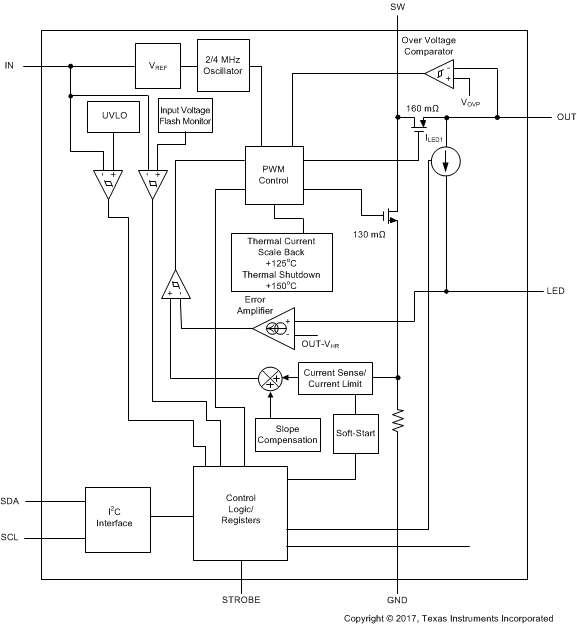
7.3 Feature Description
7.3.1 Flash Mode
In flash mode, the LED current source provides 128 target current levels from 11 mA to 1.5 A, set by the LED Flash Brightness Register (0x03 bits [6:0]). Flash mode is activated by the Enable Register (0x01), setting mode M1, M0 (bits [1:0]) to 11. Once the flash sequence is activated, the LED current source ramps up to the programmed flash current by stepping through all current steps until the programmed current is reached. The headroom on the current source is regulated to provide 11 mA to 1.5 A.
When flash mode is enabled using the mode M1, M0 (bits [1:0]) of the Enable Register (0x01), the mode bits in the Enable Register are cleared after a flash time-out event.
7.3.2 Torch Mode
In torch mode, the LED current source provides 128 target current levels from 2.4 mA to 376 mA, set by the LED Torch Brightness Register (0x04 bits [6:0]). Torch mode is activated by the Enable Register (0x01), setting mode M1, M0 (bits [1:0]) to 10. Once the TORCH sequence is activated, the LED current source ramps up to the programmed torch current by stepping through all current steps until the programmed current is reached. The rate at which the current ramps is determined by the value chosen in the Torch Ramp bit [0] in Timing Register (0x02).
7.3.3 IR Mode
In IR mode, the target LED current is equal to the value stored in the LED Flash Brightness Register (0x03 bits [7:0]). When IR mode is enabled by the Enable Register (0x01) setting mode M1, M0 (bits [1:0]) to 01, the boost converter turns on and sets the output equal to the input (pass mode). In IR mode, toggling the STROBE pin enables and disables the LED current source. The STROBE pin can only be set to be Level sensitive, as all timing of the IR pulse is externally controlled. In IR mode, the current source does not control the ramp rate of the LED output. The current transitions immediately from off to on and then on to off.
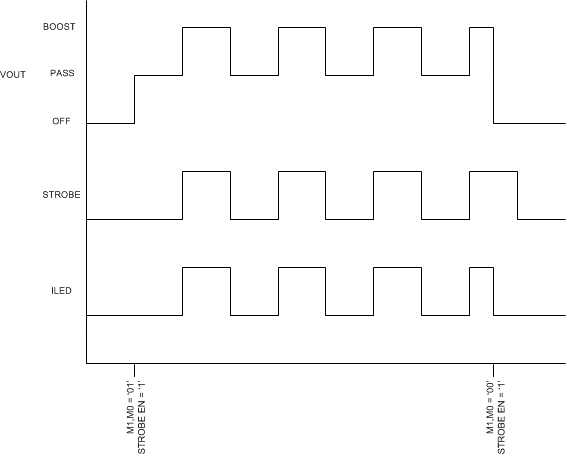
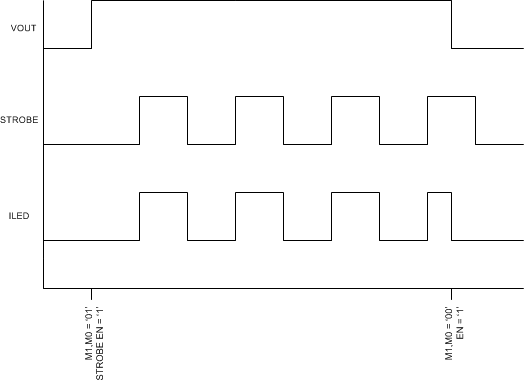
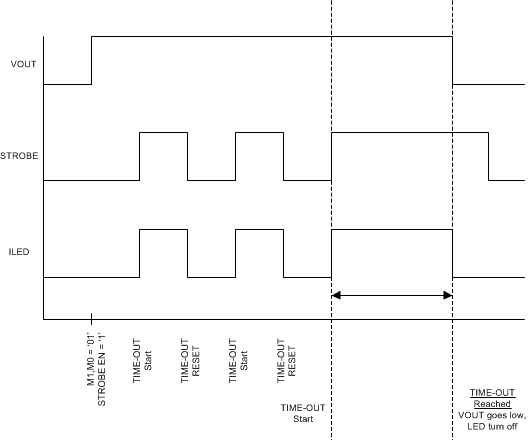
7.4 Device Functioning Modes
7.4.1 Start-Up (Enabling The Device)
At turnon the LED current source steps through each FLASH or TORCH level until the target LED current is reached. This gives the device a controlled turnon and limits inrush current from the VIN supply. The target LED flash and the target LED torch currents are set by the LED Flash Brightness Register (0x03 bits [6:0]) and LED Torch Brightness Register (0x04 bits [6:0]) respectively.
7.4.2 Pass Mode
The LM36010 starts up in pass mode and stays there until boost mode is needed to maintain regulation. If the voltage difference between VOUT and VLED falls below VHR, the device switches to boost mode. In pass mode, the boost converter does not switch, the synchronous PFET turns fully on bringing VOUT up to VIN – ILED × RPMOS, and the inductor current is not limited by the peak current limit.
7.4.3 Input Voltage Flash Monitor (IVFM)
The LM36010 has the ability to adjust the flash current based upon the voltage level present at the IN pin utilizing the input voltage flash monitor (IVFM). The adjustable threshold IVFM-D ranges from 2.9 V to 3.6 V in 100-mV steps and is set by Configuration Register (0x02) bits [7:5]. Additionally, the IVFM-D threshold sets the input voltage boundary that forces the LM36010 to stop ramping the flash current during start-up.
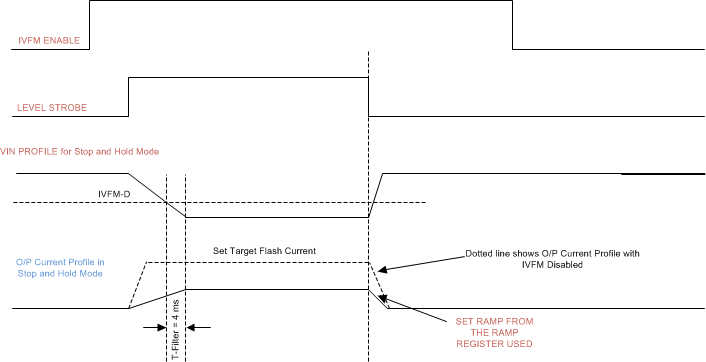 Figure 32. IVFM Mode
Figure 32. IVFM Mode
7.4.4 Fault/Protections
Upon a fault condition, the LM36010 sets the appropriate flag(s) in the Flags Register (0x05) and switches into stand-by mode obtained by clearing the mode M1, M0 (bits [1:0]) of the Enable Register (0x01). The LM36010 remains in standby until an I2C read of the Flags Register. I2C read of the Flags Register clears the flags and the fault status can be re-checked. If the fault(s) is still present, the LM36010 re-sets the appropriate flag bits and enters stand-by again.
7.4.4.1 Overvoltage Protection (OVP)
The output voltage is limited to typically 5 V (see VOVP specification in the Electrical Characteristics). In situations such as an open LED, the LM36010 raises the output voltage in order to keep the LED current at its target value. When VOUT reaches 5 V (typical), the overvoltage comparator trips and turns off the internal NFET. When OVP condition is present for three consecutive OVP events, LM36010 enters stand-by mode and OVP flag (bit [0]) of Flags Register (0x01) is set. Checking for three consecutive events prevents forcing the device to shut down due to momentary OVP condition. When VOUT falls below the VOVP off threshold, the LM36010 switches again.
7.4.4.2 Input Voltage Flash Monitor (IVFM)
When the input voltage crosses the IVFM-D value, programmed by Configuration Register (0x02) bits [7:5], the LM36010 sets the IVFM flag (bit [6]) of Flags Register (0x05).
7.4.4.3 LED and/or VOUT Short Fault
LM36010 enters stand-by mode from flash or torch mode and VLED Short Fault flag (bit [5]) of Flags Register (0x05) is set, if the LED output and/or VOUT experiences a short condition. An LED short condition occurs if the voltage at the LED pin goes below 500 mV (typical). There is a deglitch time of 256 µs before the LED short flag is valid, and a deglitch time of 2.048 ms before the VOUT short flag is valid. The LED and/or VOUT short fault can be reset to 0 by removing power to the LM36010, or setting the software reset field (Register 0x06 bit [7]) to a 1, or by reading back the Flags Register.
7.4.4.4 Current Limit (OCP)
The LM36010 features two selectable inductor current limits, 1.9A and 2.8A, programmable through the I2C-compatible interface by writing to Register 0x01 bit [5] . When the inductor current limit is reached, the LM36010 terminates the charging phase of the switching cycle and sets the OCP flag (bit [4]) of Flags Register (0x05). However, the mode M1, M0 (bits [1:0]) are not cleared as the device operates at current limit. Switching resumes at the start of the next switching period.
In pass mode, there is no mechanism to limit the current as the current does not flow through the NMOS, which senses the current limit.
In the boost mode or the pass mode, if VOUT falls below 2.3 V, the device stops switching, and the PFET operates as a current source limiting the current to 200 mA. This prevents the LM36010 from drawing excessive current from the battery during output short-circuit conditions.
7.4.4.5 Thermal Scale-Back (TSB)
When the LM36010 die temperature reaches 125°C, the thermal scale-back (TSB) circuit trips and TSB flag (bit [2]) of Flags Register (0x05) is set. The LED current then shifts to torch current level, set by the LED Torch Brightness Register (0x04 bits [6:0]) for the duration of the flash pulse, set by the flash time-out in the Configuration Register (0x02 bits [4:1]) After I2C read of the Flags Register and upon re-flash, if the die temperature is still above 125°C, the LM36010 re-enters into torch current level and sets the TSB flag bit again.
7.4.4.6 Thermal Shutdown (TSD)
When the LM36010 die temperature reaches 150°C, the thermal shutdown (TSD) circuit trips, forcing the LM36010 into standby and writing a 1 to the TSD flag (bit [2]) of the Flags Register (0x05). The LM36010 restarts only after the Flags Register is read, which clears the fault flag. Upon restart, if the die temperature is still above 150°C, the LM36010 resets the TSD flag and re-enters standby.
7.4.4.7 Undervoltage Lockout (UVLO)
The LM36010 has an internal comparator that monitors the voltage at IN pin. If the input voltage drops to 2.5 V, the UVLO flag (bit [1]) of Flags Register (0x05) is set and the LM36010 switches to stand-by mode. After the UVLO flag is set, even if the input voltage rises above 2.5 V, the LM36010 is not available for operation until there is an I2C read of the Flags Register. Upon an I2C read of the Flags Register, the UVLO fault is cleared and normal operation can resume.
7.4.4.8 Flash Time-out (FTO)
The LM36010 sources the flash current for the time period set by Flash Time-out (0x02 bits [4:1]). The LED current source has 16 time-out levels ranging from 40 ms to 1600 ms.
7.5 Programming
7.5.1 Control Truth Table
| M1 (Register 0x01 bit[1]) | M0 (Register 0x01 bit[0]) | STROBE EN (Register 0x01 bit[2]) | STROBE PIN | ACTION |
|---|---|---|---|---|
| 0 | 0 | 0 | X | Standby |
| 0 | 0 | 1 | pos edge | Ext flash |
| 1 | 0 | X | X | Int torch |
| 1 | 1 | X | X | Int flash |
| 0 | 1 | 0 | X | IR LED standby |
| 0 | 1 | 1 | 0 | IR LED standby |
| 0 | 1 | 1 | pos edge | IR LED enabled |
7.5.2 I2C-Compatible Interface
7.5.2.1 Data Validity
The data on SDA must be stable during the HIGH period of the clock signal (SCL). In other words, the state of the data line can only be changed when SCL is LOW.
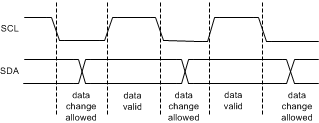 Figure 33. Data Validity Data
Figure 33. Data Validity Data
A pullup resistor between the VIO line of the controller and SDA must be greater than [(VIO – VOL) / 3 mA] to meet the VOL requirement on SDA. Using a larger pullup resistor results in lower switching current with slower edges, while using a smaller pullup resistor results in higher switching currents with faster edges.
7.5.2.2 Start and Stop Conditions
START and STOP conditions classify the beginning and the end of the I2C session. A START condition is defined as the SDA signal transitioning from HIGH to LOW while SCL line is HIGH. A STOP condition is defined as the SDA transitioning from LOW to HIGH while SCL is HIGH. The I2C master always generates START and STOP conditions. The I2C bus is considered busy after a START condition and free after a STOP condition. During data transmission, the I2C master can generate repeated START conditions. First START and repeated START conditions are equivalent, function-wise.
 Figure 34. Start and Stop Conditions
Figure 34. Start and Stop Conditions
7.5.2.3 Transferring Data
Every byte put on the SDA line must be eight bits long, with the most significant bit (MSB) transferred first. Each byte of data has to be followed by an acknowledge bit. The acknowledge related clock pulse is generated by the master. The master releases the SDA line (HIGH) during the acknowledge clock pulse. The LM36010 pulls down the SDA line during the 9th clock pulse, signifying an acknowledge. The LM36010 generates an acknowledge after each byte is received. There is no acknowledge created after data is read from the device.
After the START condition, the I2C master sends a chip address. This address is seven bits long followed by an eighth bit which is a data direction bit (R/W). The LM36010 7-bit address is 0x64. For the eighth bit, a 0 indicates a WRITE, and a 1 indicates a READ. The second byte selects the register to which the data is written. The third byte contains data to write to the selected register.
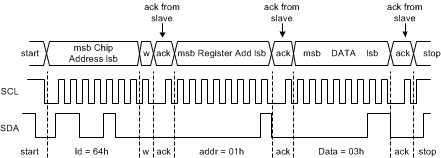 Figure 35. Write Cycle W = Write (SDA = 0) R = Read (SDA = 1) Ack = Acknowledge
Figure 35. Write Cycle W = Write (SDA = 0) R = Read (SDA = 1) Ack = Acknowledge (SDA Pulled Down by Either Master or Slave) ID = Chip Address, 64h for LM36010
7.5.2.4 I2C-Compatible Chip Address
The device address for the LM36010 is 1100100 (0x64). After the START condition, the I2C-compatible master sends the 7-bit address followed by an eighth read or write bit (R/W). R/W = 0 indicates a WRITE and R/W = 1 indicates a READ. The second byte following the device address selects the register address to which the data is written. The third byte contains the data for the selected register.
 Figure 36. I2C-Compatible Chip Address
Figure 36. I2C-Compatible Chip Address
7.6 Register Descriptions
| REGISTER NAME | INTERNAL HEX ADDRESS | POWER ON/RESET VALUE |
|---|---|---|
| LM36010 | ||
| Enable Register | 0x01 | 0x20 |
| Configuration Register | 0x02 | 0x15 |
| LED Flash Brightness Register | 0x03 | 0x00 |
| LED Torch Brightness Register | 0x04 | 0x00 |
| Flags Register | 0x05 | 0x00 |
| Device ID Register | 0x06 | 0x01 |
7.6.1 Enable Register (0x01)
| Bit 7 | Bit 6 | Bit 5 | Bit 4 | Bit 3 | Bit 2 | Bit 1 | Bit 0 |
|---|---|---|---|---|---|---|---|
| Boost Mode
0 = Normal (Default) 1 = Pass Mode Only |
Boost Frequency Select
0 = 2 MHz (Default) 1 = 4 MHz |
Boost Current Limit Setting
0 = 1.9 A 1 = 2.8 A (Default) |
IVFM Enable
0 = Disabled (Default) 1 = Enabled |
Strobe Type
0 = Level Triggered (Default) 1 = Edge Triggered |
Strobe Enable
0 = Disabled (Default ) 1 = Enabled |
Mode Bits: M1, M0
00 = Standby (Default) 01 = IR Drive 10 = Torch 11 = Flash |
|
NOTE
Edge strobe mode is not valid in IR MODE. Switching between level and edge strobe types while the device is enabled is not recommended.
In edge or level strobe mode, TI recommends that the trigger pulse width be set greater than 1 ms to ensure proper turn-on of the device.
7.6.2 Configuration Register (0x02)
| Bit 7 | Bit 6 | Bit 5 | Bit 4 | Bit 3 | Bit 2 | Bit 1 | Bit 0 |
|---|---|---|---|---|---|---|---|
| IVFM Levels (IVFM-D)
000 = 2.9 V (Default) 001 = 3 V 010 = 3.1 V 011 = 3.2 V 100 = 3.3 V 101 = 3.4 V 110 = 3.5 V 111 = 3.6 V |
Flash Time-out Duration
0000 = 40 ms 0001 = 80 ms 0010 = 120 ms 0011 = 160 ms 0100 = 200 ms 0101 = 240 ms 0110 = 280 ms 0111 = 320 ms 1000 = 360 ms 1001 = 400 ms 1010 = 600 ms (Default) 1011 = 800 ms 1100 = 1000 ms 1101 = 1200 ms 1110 = 1400 ms 1111 = 1600 ms |
Torch Ramp
0 = No Ramp 1 = 1 ms (default) |
|||||
NOTE
On the LM36010, special care must be taken with regards to thermal management when using time-out values greater than 500 ms. Depending on the PCB layout, input voltage, and output current, it is possible to have the internal thermal shutdown circuit trip prior to reaching the desired flash time-out value.
7.6.3 LED Flash Brightness Register (0x03)
| Bit 7 | Bit 6 | Bit 5 | Bit 4 | Bit 3 | Bit 2 | Bit 1 | Bit 0 |
|---|---|---|---|---|---|---|---|
| Thermal Current Scale-Back
0 = Disabled 1 = Enabled (default) If enabled, the LED current shifts to torch current level if TJ reaches 125 °C |
LED Flash Brightness Level
0000000 = 11 mA (Default) ....................... 00010101 (0x15) = 0.257 A ....................... 0111111 (0x3F) = 0.75 A ....................... 0101111 (0x5F) = 1.03 A ....................... 01100110 (0x66) = 1.2 A ....................... 1111111 (0x7F) = 1.5 A |
||||||
7.6.4 LED Torch Brightness Register (0x04)
| Bit 7 | Bit 6 | Bit 5 | Bit 4 | Bit 3 | Bit 2 | Bit 1 | Bit 0 |
|---|---|---|---|---|---|---|---|
| RFU | LED Torch Brightness Levels
0000000 = 2.4 mA (Default) ....................... 00010101 (0x15) = 64 mA ....................... 0111111 (0x3F) = 188 mA ....................... 0101111 (0x5F) = 258 mA ....................... 01100110 (0x66) = 302 mA ....................... 1111111 (0x7F) = 376 mA |
||||||
7.6.5 Flags Register (0x05)
| Bit 7 | Bit 6 | Bit 5 | Bit 4 | Bit 3 | Bit 2 | Bit 1 | Bit 0 |
|---|---|---|---|---|---|---|---|
| OVP Fault | IVFM Trip Flag | VOUT / VLED Short Fault | Current Limit Flag | Thermal Current Scale-back (TSB) Flag | Thermal Shutdown (TSD) Fault | UVLO Fault | Flash Time-Out Flag |
7.6.6 Device ID and RESET Register (0x06)
| Bit 7 | Bit 6 | Bit 5 | Bit 4 | Bit 3 | Bit 2 | Bit 1 | Bit 0 |
|---|---|---|---|---|---|---|---|
| Software RESET
0 = Normal (default) 1 = Force device RESET |
RFU | Device ID
000 |
Silicon Revision Bits
001 |
||||